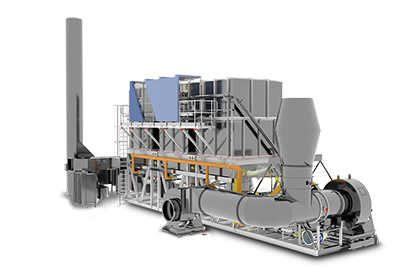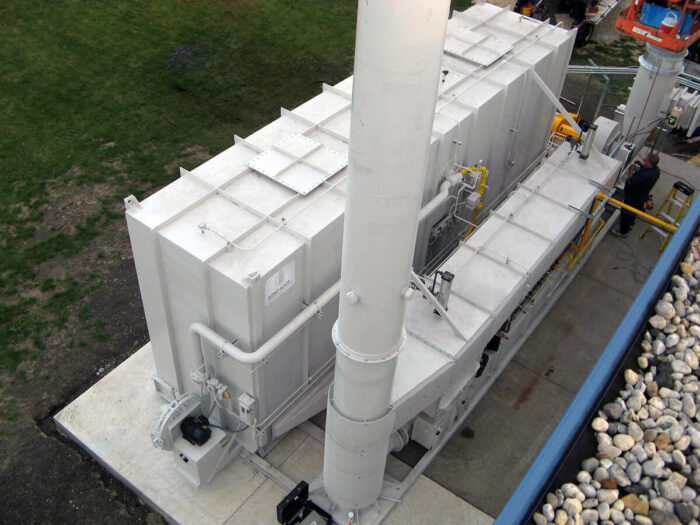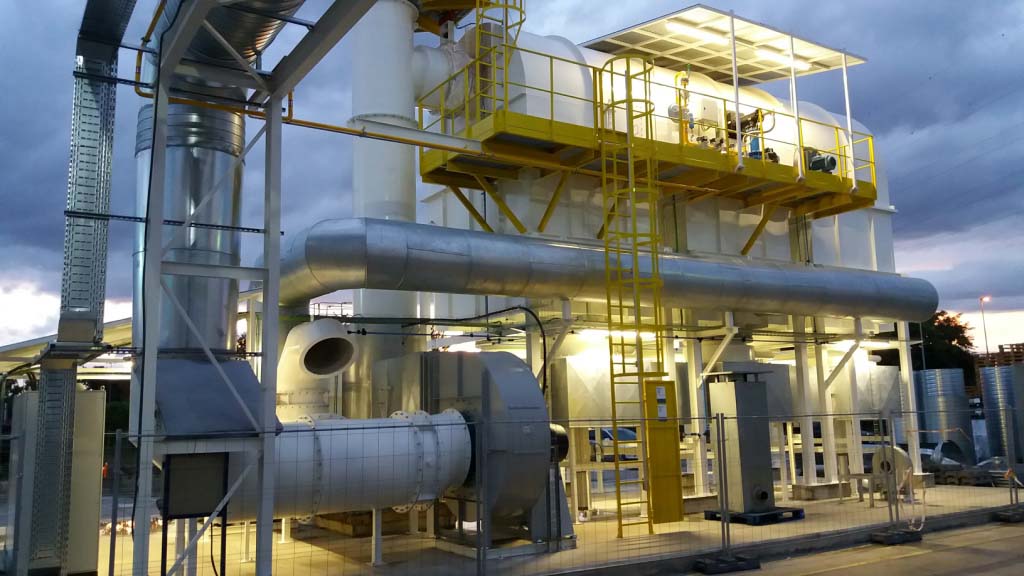Maklumat Asas.
Model NO.
LC-RTO
Certification
ISO
Installation
Method
Horizontal
Operation
taip
Manually
Medium Material
Metal Fiber
Dust Collecting Method
Dry
Saving
1 M / h.;
Performance characteristics
The air volume of the treatment is from 2nm3 / h
Concentration ≥ 1000mg / m3
| Model | Air volume (m3/h); | Saiz (mm); | Burner(thousand Kcal); |
| LC-RTO -50 | 5000 | 5280*1790*3910 | 250 |
| LC-RTO -100 | 10000 | 6150*2380*4030 | 550 |
| LC-RTO -150 | 15000 | 7050*2830*4310 | 750 |
| LC-RTO -200 | 20000 | 7980*3150*4610 | 1000 |
| LC-RTO -300 | 30000 | 10650*4260*4950 | 1350 |
| LC-RTO -400 | 40000 | 12560*4720*5460 | 2000 |
| LC-RTO -500 | 50000 | 14200*5260*5860 | 2000 |
FAQ:;
Customer Question & Answer
If you have any questions,; please leave your valuable comments
Address: 316, No. 331, Chengnan Road, Lancheng Street, HangZhou City, ZheJiang Province
Business Type: Manufacturer/Factory
Business Range: Industrial Equipment & Components
Main Products: Waste Incineration Power Generation, Waste Incineration, Renergy Power Generation, Waste Incineration Power Plant, Refuse Incinerator, Energy
Company Introduction: HangZhou Lancheng Environmental Protection Technology Co., Ltd., located in HangZhou City, HangZhou City, ZheJiang Province, is a high-tech enterprise integrating scientific research, design, production and sales. The company strives for innovation with scientific research, survival with quality and development with reputation. With its professional level and mature technology in the field of environmental protection, it is rising rapidly. Customer satisfaction with products is our constant pursuit.
With a registered capital of 20 million yuan, the company has more than 2000 modern production bases in HangZhou Hong Kong Industrial Zone, HangZhou City, HangZhou City, ZheJiang Province. The company′s first-class environmental protection treatment designers have designed targeted treatment schemes from the aspects of system rationality, technological innovation and input-output economy for various complex working conditions, so as to make the emission indicators meet the national emission standards.
The company′s main products are: 1. Organic waste gas; Activated carbon, RTO, RCO, zeolite runner, dry filter box, etc. 2. Dust; Electrostatic precipitator, pulse bag filter and other equipment. 3. Pharmaceutical equipment; Drying equipment, mixing equipment, granulation equipment, crushing equipment. 4. Hot DIP galvanized wire. 5. Industrial wastewater treatment equipment, etc.
Our equipment has been successfully used in chemical industry, baking, coating, electroplating, waste incineration, printing, catering, municipal and other industries. At present, the company can formulate a perfect treatment scheme according to the current situation of enterprise sewage discharge, and use the existing patented technology to develop the most suitable products. We will provide you with the best quality solutions with the most advanced technology and the most sincere attitude.
The company always takes “carving carefully and creating high-quality products” as the enterprise purpose, and always takes “growing into the strongest environmental protection enterprise in Xihu (West Lake) Dis.” as the enterprise goal. In recent years, with the increasing attention of the state to environmental protection, “managing the atmosphere, beautifying the environment and benefiting mankind” has become our long-term task. In response to the call of the national “energy conservation and emission reduction” policy, blue city environmental protection company has made due contributions to revitalizing China′s environmental protection and building a harmonious society, and continues to strive to create a bluer sky and a better environment for us!

Bagaimanakah pengoksida terma regeneratif dibandingkan dengan pengoksida pemangkin?
Pengoksida terma regeneratif (RTO) dan pengoksida pemangkin adalah kedua-dua teknologi berkesan yang digunakan untuk mengawal pelepasan udara daripada proses perindustrian. Walaupun ia mempunyai tujuan yang sama, terdapat perbezaan yang ketara dalam operasi, kecekapan dan kebolehgunaannya.
Berikut ialah perbandingan antara RTO dan pengoksida pemangkin:
| Pengoksida Terma Regeneratif (RTO) | Pengoksida Bermangkin |
|---|---|
| Operasi: | Operasi: |
| RTO mencapai kawalan pelepasan melalui pembakaran suhu tinggi tanpa menggunakan pemangkin. Mereka bergantung pada proses pengoksidaan terma, di mana VOC dan bahan pencemar lain dalam gas ekzos teroksida pada suhu tinggi (biasanya antara 1,400°F dan 1,600°F) dengan kehadiran oksigen berlebihan. | Pengoksida pemangkin menggunakan mangkin (biasanya logam berharga, seperti platinum, paladium, atau rhodium) untuk memudahkan pengoksidaan VOC dan bahan pencemar lain pada suhu yang lebih rendah berbanding dengan RTO. Mangkin merendahkan tenaga pengaktifan yang diperlukan untuk tindak balas pengoksidaan, membolehkannya berlaku pada suhu yang lebih rendah (sekitar 600°F hingga 900°F). |
| Kecekapan: | Kecekapan: |
| RTO terkenal dengan kecekapan haba yang tinggi. Mereka menggunakan sistem penukar haba regeneratif yang memulihkan dan memindahkan haba daripada gas ekzos yang dirawat kepada gas yang tidak dirawat yang masuk, dengan ketara mengurangkan penggunaan bahan api. Mekanisme pemulihan haba ini menjadikan RTO cekap tenaga. | Pengoksida pemangkin biasanya lebih cekap tenaga daripada RTO kerana ia beroperasi pada suhu yang lebih rendah. Mangkin memudahkan tindak balas pengoksidaan, membolehkan ia berlaku pada suhu yang lebih rendah, yang mengurangkan keperluan tenaga untuk memanaskan gas ekzos. |
| Kebolehgunaan: | Kebolehgunaan: |
| RTO amat sesuai untuk aplikasi di mana kepekatan pencemar adalah tinggi, atau di mana terdapat variasi yang luas dalam kadar aliran atau kepekatan pencemar. Ia biasanya digunakan untuk mengawal sebatian organik meruap (VOC) dan bahan pencemar udara berbahaya (HAP) dalam pelbagai industri, termasuk pembuatan kimia, percetakan, salutan dan farmaseutikal. | Pengoksida pemangkin selalunya diutamakan dalam aplikasi di mana kepekatan pencemar adalah agak rendah dan agak malar. Ia berkesan untuk kawalan VOC dalam aplikasi seperti pengecatan automotif, percetakan, dan pemprosesan makanan, di mana kepekatan VOC boleh lebih rendah dan lebih konsisten. |
| Had: | Had: |
| RTO mempunyai kos modal yang lebih tinggi berbanding dengan pengoksida pemangkin kerana reka bentuk yang kompleks dan sistem pemulihan haba. Ia juga mempunyai suhu operasi yang lebih tinggi, yang mungkin mengehadkan kebolehgunaannya dalam proses tertentu atau memerlukan sistem pemulihan haba tambahan. | Pengoksida pemangkin boleh menjadi sensitif kepada racun atau bahan cemar dalam gas ekzos yang boleh menyahaktifkan atau merendahkan mangkin dari semasa ke semasa. Sebatian tertentu, seperti sulfur, silikon atau sebatian halogen, berpotensi meracuni mangkin, mengurangkan keberkesanannya dan memerlukan penggantian atau penjanaan semula mangkin secara berkala. |
Apabila memilih antara RTO dan pengoksida pemangkin, adalah penting untuk mempertimbangkan keperluan khusus aplikasi, termasuk kepekatan pencemar, kadar aliran, keperluan suhu dan pertimbangan kos. Berunding dengan profesional kejuruteraan alam sekitar atau pengeluar peralatan boleh membantu menentukan teknologi yang paling sesuai untuk keperluan kawalan pelepasan tertentu.

Are regenerative thermal oxidizers suitable for controlling emissions from printing presses?
Yes, regenerative thermal oxidizers (RTOs) can be suitable for controlling emissions from printing presses. Printing presses can emit volatile organic compounds (VOCs) and other air pollutants during the printing process, which need to be properly controlled to comply with environmental regulations and ensure air quality. Here are some key points regarding the suitability of RTOs for controlling emissions from printing presses:
- Kawalan pelepasan: RTOs are designed to achieve high destruction efficiencies for VOCs and hazardous air pollutants (HAPs). These pollutants are oxidized within the RTO at high temperatures, typically above 95% efficiency, converting them into carbon dioxide (CO2) and water vapor. RTOs effectively control and reduce emissions from printing presses.
- Compatibility: RTOs can be integrated into the exhaust system of printing presses, capturing and treating the emissions before they are released into the atmosphere. The RTO is typically connected to the exhaust stack of the printing press, allowing the VOC-laden air to pass through the oxidizer for treatment.
- High Flow Rates: Printing presses can generate significant exhaust volumes due to the printing process. RTOs are designed to handle high flow rates and can accommodate the varying exhaust volumes of printing presses. This ensures effective treatment of emissions even during peak production periods.
- Kapasiti Terma: RTOs have the thermal capacity to handle the temperature variations in printing press emissions. The printing process can result in varying exhaust temperatures, and RTOs are designed to operate effectively within a wide range of temperature conditions.
- Energy Efficiency: RTO menggabungkan sistem pertukaran haba yang membolehkan pemulihan dan penggunaan semula tenaga haba. Penukar haba dalam RTO menangkap haba daripada gas ekzos yang keluar dan memindahkannya ke aliran udara atau gas proses masuk. Proses pemulihan haba ini meningkatkan kecekapan tenaga keseluruhan sistem dan mengurangkan keperluan untuk penggunaan bahan api tambahan.
- Pematuhan dengan Peraturan: Printing press emissions are subject to regulatory requirements for air quality and emissions control. RTOs are capable of achieving the necessary destruction efficiencies and can help printing press operators comply with environmental regulations. The use of RTOs demonstrates a commitment to sustainable practices and responsible management of air emissions.
It is important to note that the specific design and configuration of the RTO, as well as the characteristics of the printing press emissions, should be considered when implementing an RTO for a printing press application. Consulting with experienced engineers or RTO manufacturers can provide valuable insights into the proper sizing, integration, and performance requirements for controlling emissions from printing presses.
In summary, RTOs are a suitable technology for controlling emissions from printing presses, providing high destruction efficiencies, compatibility with printing press exhaust systems, handling high flow rates and temperature variations, energy efficiency through heat recovery, and compliance with environmental regulations.

How efficient are regenerative thermal oxidizers in destroying volatile organic compounds (VOCs)?
Regenerative thermal oxidizers (RTOs) are highly efficient in destroying volatile organic compounds (VOCs) emitted from industrial processes. Here are the reasons why RTOs are considered efficient in VOC destruction:
1. Kecekapan Pemusnahan Tinggi: RTOs are known for their high destruction efficiency, typically exceeding 99%. They effectively oxidize VOCs present in the industrial exhaust streams, converting them into less harmful byproducts, such as carbon dioxide and water vapor. This high destruction efficiency ensures that the majority of VOCs are eliminated, resulting in cleaner emissions and compliance with environmental regulations.
2. Residence Time: RTOs provide a sufficiently long residence time for the combustion of VOCs. In the RTO chamber, the VOC-laden air is directed through a ceramic media bed, which acts as a heat sink. The VOCs are heated to the combustion temperature and react with the available oxygen, leading to their destruction. The design of RTOs ensures that the VOCs have ample time to undergo complete combustion before being released into the atmosphere.
3. Temperature Control: RTOs maintain the combustion temperature within a specific range to optimize VOC destruction. The operating temperature is carefully controlled based on factors such as the type of VOCs, their concentration, and the specific requirements of the industrial process. By controlling the temperature, RTOs ensure that the VOCs are efficiently oxidized, maximizing destruction efficiency while minimizing the formation of harmful byproducts, such as nitrogen oxides (NOx).
4. Heat Recovery: RTOs incorporate a regenerative heat recovery system, which enhances their overall energy efficiency. The system captures and preheats the incoming process air by utilizing the heat energy from the outgoing exhaust stream. This heat recovery mechanism minimizes the amount of external fuel required to sustain the combustion temperature, resulting in energy savings and cost-effectiveness. The heat recovery also helps maintain the high destruction efficiency of VOCs by providing a consistent and optimized operating temperature.
5. Catalyst Integration: In some cases, RTOs can be equipped with catalyst beds to further enhance VOC destruction efficiency. Catalysts can accelerate the oxidation process and lower the required operating temperature, improving the overall efficiency of VOC destruction. Catalyst integration is particularly beneficial for processes with lower VOC concentrations or when specific VOCs require lower temperatures for effective oxidation.
6. Compliance with Regulations: The high destruction efficiency of RTOs ensures compliance with environmental regulations governing VOC emissions. Many industrial sectors are subject to stringent air quality standards and emission limits. RTOs provide an effective solution for meeting these requirements by reliably and efficiently destroying VOCs, reducing their impact on air quality and public health.
In summary, regenerative thermal oxidizers (RTOs) are highly efficient in destroying volatile organic compounds (VOCs). Their high destruction efficiency, residence time, temperature control, heat recovery capabilities, optional catalyst integration, and compliance with regulations make RTOs a preferred choice for industries seeking effective and sustainable solutions for VOC abatement.
editor by CX 2023-08-31
